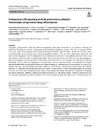Identificador persistente para citar o vincular este elemento:
https://accedacris.ulpgc.es/jspui/handle/10553/132057
| Título: | Endogenous LXR signaling controls pulmonary surfactant homeostasis and prevents lung inflammation | Autores/as: | Hernández Hernández, Irene De La Rosa Medina, Juan Vladimir Martín Rodríguez, Patricia Diaz Sarmiento,Maria Mercedes Recio Cruz, Carlota Pilar Guerra Hernández, Carlos Borja Fernández Pérez, Leandro Francisco León, Theresa E. Torres, Rosa Font-Díaz, Joan Roig, Angela de Mora, Fernando Boscá, Lisardo Díaz González, Mario Lorenzo Valledor Annabel F. Castrillo Viguera, Antonio Jesús Tabraue Tarbay, Carlos |
Clasificación UNESCO: | 320508 Enfermedades pulmonares | Palabras clave: | LXR Alveolar macrophage Type 2 pneumocyte Surfactant Inflammation, et al. |
Fecha de publicación: | 2024 | Proyectos: | PID2019-104284RBI00 PID2022-137696OB-I00 PID2020-119875RB-I00 SAF2017-89510-R SAF2017-90604-REDT PI18/01702 PROID2017010050 PRE2018-085579 BES200901219 |
Publicación seriada: | Cellular and Molecular Life Sciences | Resumen: | Lung type 2 pneumocytes (T2Ps) and alveolar macrophages (AMs) play crucial roles in the synthesis, recycling and catabolism of surfactant material, a lipid/protein fluid essential for respiratory function. The liver X receptors (LXR), LXRα and LXRβ, are transcription factors important for lipid metabolism and inflammation. While LXR activation exerts anti-inflammatory actions in lung injury caused by lipopolysaccharide (LPS) and other inflammatory stimuli, the full extent of the endogenous LXR transcriptional activity in pulmonary homeostasis is incompletely understood. Here, using mice lacking LXRα and LXRβ as experimental models, we describe how the loss of LXRs causes pulmonary lipidosis, pulmonary congestion, fibrosis and chronic inflammation due to defective de novo synthesis and recycling of surfactant material by T2Ps and defective phagocytosis and degradation of excess surfactant by AMs. LXR-deficient T2Ps display aberrant lamellar bodies and decreased expression of genes encoding for surfactant proteins and enzymes involved in cholesterol, fatty acids, and phospholipid metabolism. Moreover, LXR-deficient lungs accumulate foamy AMs with aberrant expression of cholesterol and phospholipid metabolism genes. Using a house dust mite aeroallergen-induced mouse model of asthma, we show that LXR-deficient mice exhibit a more pronounced airway reactivity to a methacholine challenge and greater pulmonary infiltration, indicating an altered physiology of LXR-deficient lungs. Moreover, pretreatment with LXR agonists ameliorated the airway reactivity in WT mice sensitized to house dust mite extracts, confirming that LXR plays an important role in lung physiology and suggesting that agonist pharmacology could be used to treat inflammatory lung diseases. | URI: | https://accedacris.ulpgc.es/handle/10553/132057 | ISSN: | 1420-682X | DOI: | 10.1007/s00018-024-05310-3 | Fuente: | Cellular and Molecular Life Sciences [ISSN 1420-682X], v. 81 (287), (Julio 2024) |
| Colección: | Artículos |
Citas de WEB OF SCIENCETM
Citations
9
actualizado el 12-ene-2026
Visitas
7
actualizado el 10-ene-2026
Descargas
1
actualizado el 10-ene-2026
Google ScholarTM
Verifica
Altmetric
Comparte
Exporta metadatos
Los elementos en ULPGC accedaCRIS están protegidos por derechos de autor con todos los derechos reservados, a menos que se indique lo contrario.
